Creating a Greener Workspace: 5 Sustainable Office Design Ideas
Introduction

In today’s rapidly evolving business landscape, the importance of sustainability has become paramount. Companies are increasingly recognizing the need to adopt eco-friendly practices, not only to meet environmental responsibilities but also to enhance overall workplace productivity and employee well-being. One crucial aspect of this paradigm shift is the design of office spaces. A sustainable office design goes beyond aesthetics, focusing on minimizing environmental impact and fostering a healthier, more productive work environment. In this article, we explore five innovative ideas for sustainable office design that not only contribute to a greener planet but also enhance the overall work experience for employees.
The importance of sustainability in the workplace

Sustainability in the workplace has become a critical aspect of corporate responsibility and environmental stewardship. Embracing sustainable practices, especially in office design, not only aligns businesses with global efforts to combat climate change but also contributes to a healthier, more productive work environment. Sustainable office design emphasizes minimizing the environmental impact through resource conservation, waste reduction, and energy efficiency.
Companies that prioritize sustainability in their workspace demonstrate a commitment to ethical practices, which can enhance their brand image and appeal to environmentally conscious employees and clients. Beyond reputation, sustainable practices in the workplace can lead to cost savings, regulatory compliance, and long-term resilience in the face of environmental challenges. By understanding the importance of sustainability, businesses can pave the way for positive change and inspire others to follow suit.
Benefits of a greener workspace

Creating a greener workspace through sustainable office design offers a multitude of benefits, both for the environment and the people within the organization. Some key advantages include:
1. Environmental Conservation: Sustainable office design reduces the carbon footprint, conserves energy, and minimizes resource consumption, contributing to the preservation of the environment.
2. Employee Well-being: Green workspaces have been linked to improved employee well-being. Access to natural light, indoor plants, and ergonomic design can enhance comfort, reduce stress, and boost overall productivity.
3. Cost Savings: Energy-efficient practices, such as using renewable energy sources and optimizing lighting and HVAC systems, can lead to significant cost savings over time.
4. Attracting and Retaining Talent: Millennial and Gen Z employees, in particular, value sustainability. A green workspace can be a key factor in attracting and retaining top talent, especially among environmentally conscious professionals.
5. Compliance and Risk Mitigation: Adhering to sustainable practices helps organizations comply with environmental regulations and reduces the risk of legal issues related to environmental impact.
Sustainable office design trends
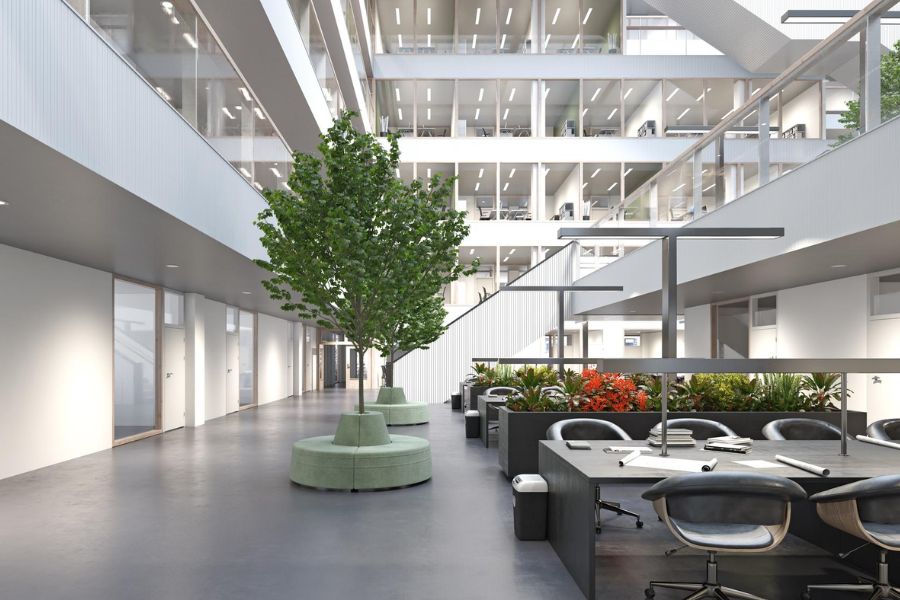
Staying abreast of sustainable office design trends is essential for businesses looking to create environmentally friendly workspaces. Some noteworthy trends include:
1. Biophilic Design: Incorporating nature into the office environment, such as through the use of plants, natural materials, and views of green spaces, promotes well-being and connection with the natural world.
2. Energy-Efficient Lighting: LED lighting and smart lighting systems help reduce energy consumption, enhance visibility, and provide customizable lighting solutions to meet specific workspace needs.
3. Flexible and Modular Spaces: Designing offices with flexible and modular furniture allows for adaptable workspaces, reducing the need for constant redesign and minimizing waste.
4. Recycled and Sustainable Materials: Utilizing recycled and sustainable materials for furniture, flooring, and finishes supports the circular economy and reduces the environmental impact of manufacturing.
Incorporating natural lighting and ventilation
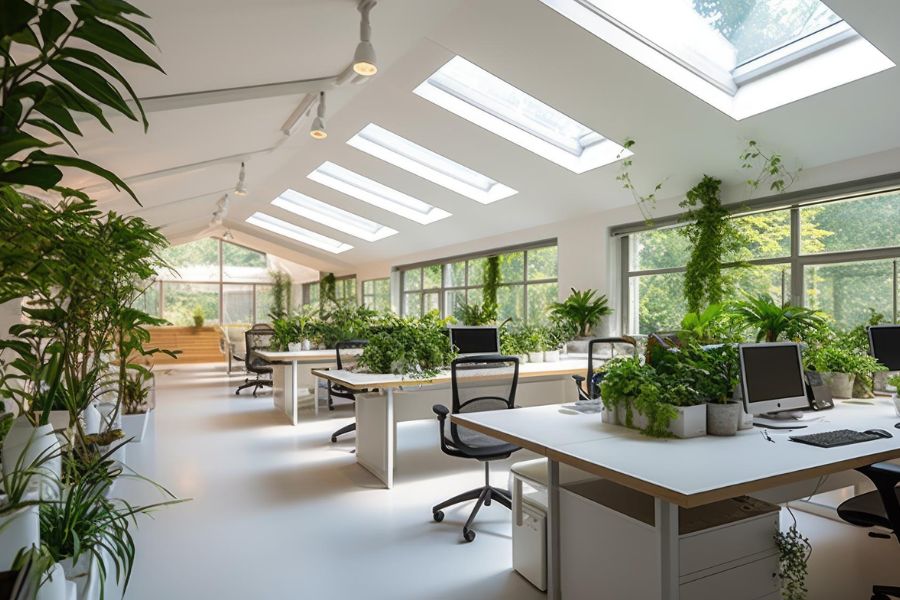
In the realm of sustainable office design, optimizing natural lighting and ventilation is paramount. By strategically incorporating large windows and skylights, workplaces can harness the power of natural sunlight, reducing the dependency on artificial lighting. This not only slashes energy consumption but also contributes to the well-being and productivity of employees.
To enhance natural ventilation, consider the installation of operable windows and ventilation systems that facilitate the circulation of fresh air. This not only reduces reliance on air conditioning but also enhances indoor air quality. Utilizing design elements such as open floor plans and glass partitions can promote the seamless flow of light and air throughout the workspace.
Using eco-friendly materials for furniture and fixtures
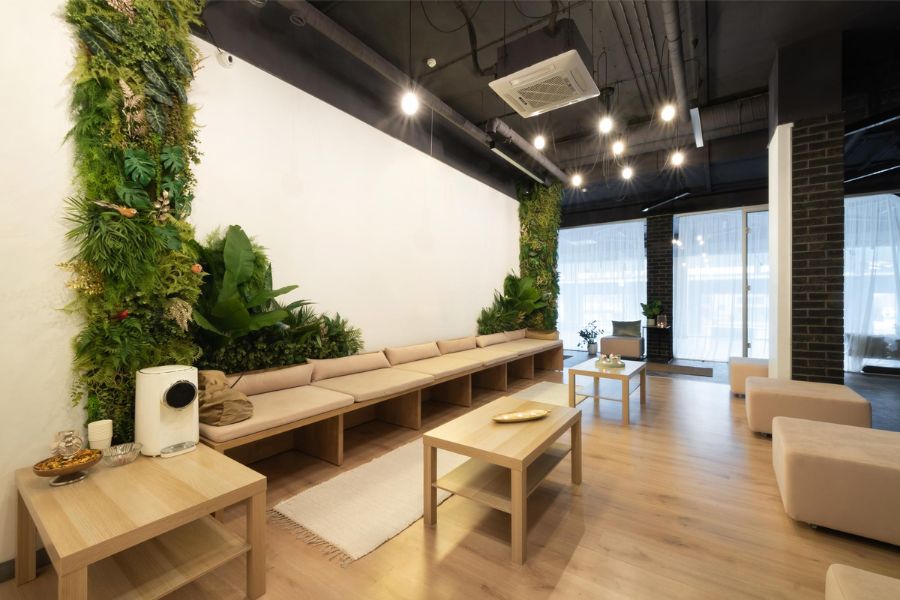
Choosing eco-friendly materials for office furniture and fixtures is a cornerstone of sustainable office design. Opt for materials with low environmental impact, such as reclaimed wood, bamboo, or recycled metal. These materials not only diminish the demand for new resources but also add a unique and natural aesthetic to the office space.
Ensure that furniture is sourced from sustainable suppliers who adhere to environmentally responsible practices. Look for certifications like FSC (Forest Stewardship Council) for wood products, and Cradle to Cradle for a comprehensive approach to product sustainability. This guarantees that the entire lifecycle of the furniture, from production to disposal, is environmentally conscious.
Integrating these sustainable office design ideas not only aligns with the global movement towards environmental responsibility but also establishes a workspace that enhances employee well-being, productivity, and satisfaction. The focus on incorporating natural elements and eco-friendly materials not only reduces the environmental footprint of the office but also sets a positive example for a more sustainable future.
Implementing energy-efficient technologies
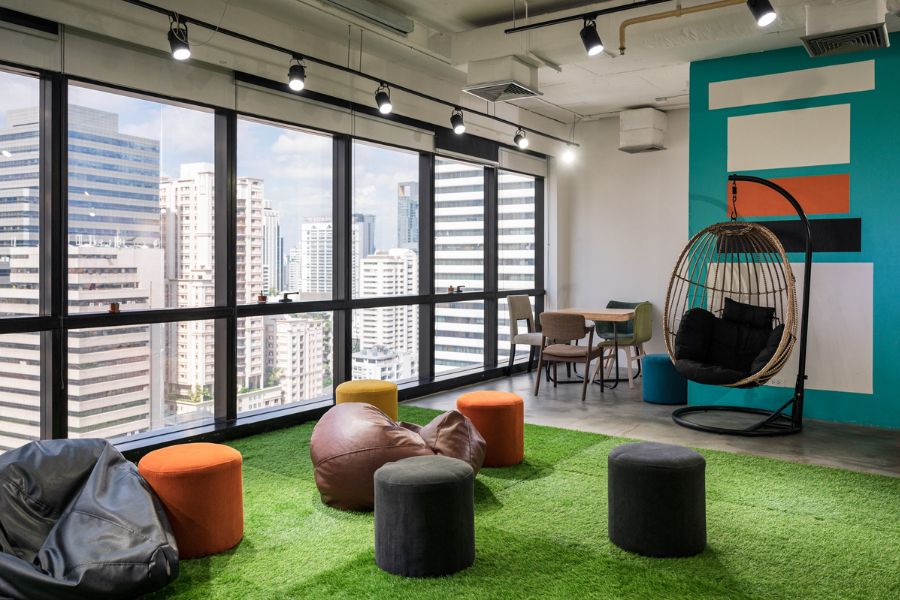
In the pursuit of a sustainable office design, integrating energy-efficient technologies is a crucial step. The implementation of such technologies not only reduces the environmental impact but also contributes to long-term cost savings. Consider incorporating LED lighting systems, which consume significantly less energy than traditional lighting options and have a longer lifespan.
Smart thermostats and HVAC systems can be employed to optimize temperature control, minimizing energy consumption without compromising comfort. Utilizing energy-efficient appliances and investing in renewable energy sources, such as solar panels, further aligns the office with sustainable practices. By incorporating these technologies, businesses can significantly reduce their carbon footprint and promote a more environmentally friendly workspace.
Creating indoor plantscapes for improved air quality
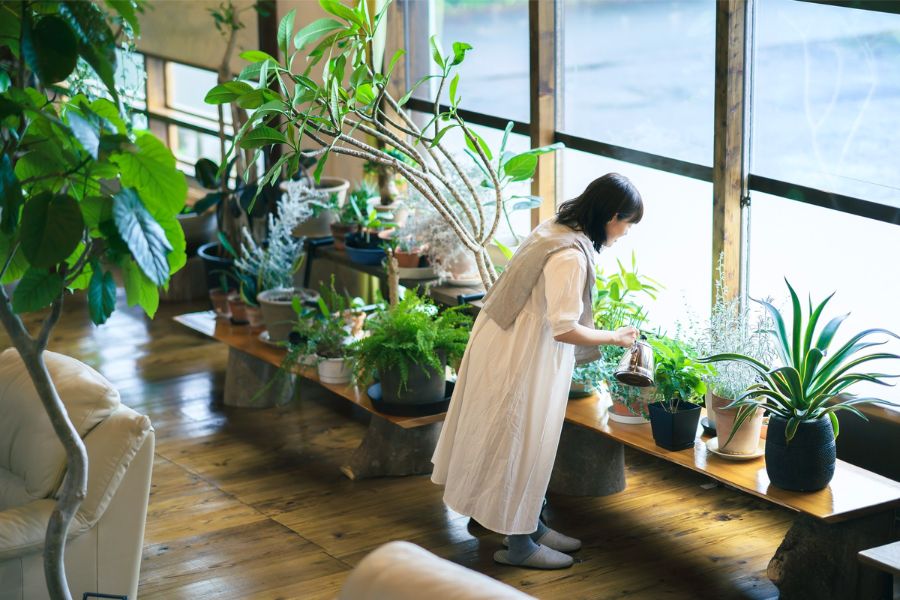
Enhancing indoor air quality is a pivotal aspect of sustainable office design, and one effective way to achieve this is by integrating indoor plantscapes. Plants act as natural air purifiers, filtering out pollutants and enhancing oxygen levels. Strategically placing a variety of air-purifying plants such as snake plants, pothos, and peace lilies throughout the office not only adds aesthetic appeal but also contributes to the well-being of employees. Consider incorporating green walls or plant partitions to maximize the greenery’s impact. Moreover, indoor plants promote a connection with nature, positively impacting employee morale, creativity, and overall productivity. Embracing indoor plantscapes is a simple yet impactful step towards creating a healthier and more sustainable office environment.
By combining energy-efficient technologies with indoor plantscapes, a sustainable office design can be achieved, providing a harmonious balance between environmental responsibility and employee well-being. These initiatives not only contribute to a greener workspace but also showcase a commitment to sustainability that can be both cost-effective and aesthetically pleasing.
Promoting waste reduction and recycling
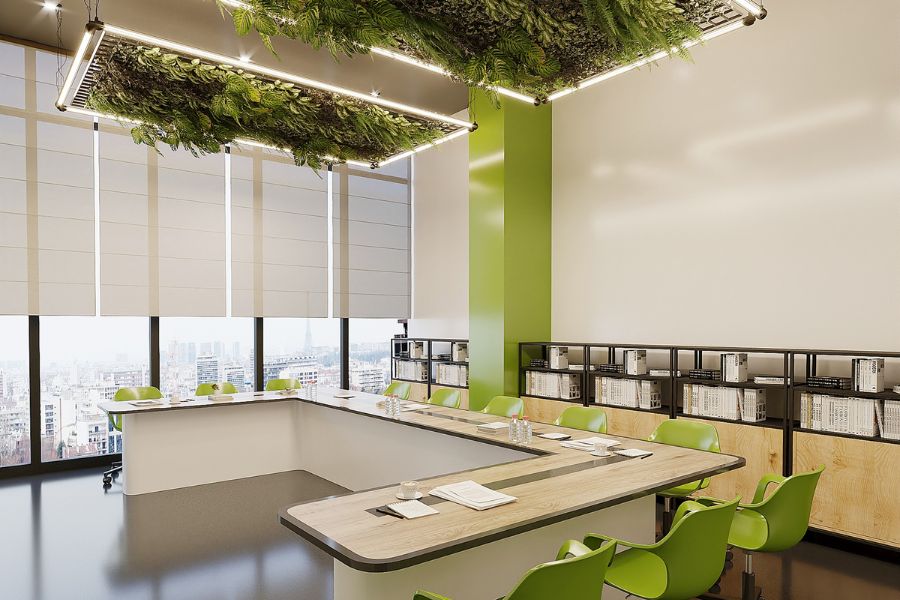
In the pursuit of a sustainable office design, promoting waste reduction and recycling is a key initiative. The primary goal is to minimize the environmental impact of the workplace by implementing strategies that reduce the generation of waste and encourage responsible disposal practices. Here’s a closer look at some effective ideas:
1. Waste Audits: Conduct regular waste audits to identify the types and quantities of waste generated. his data helps in developing targeted reduction strategies.
2. Comprehensive Recycling Stations: Set up well-labeled and easily accessible recycling stations throughout the office space. Clearly define what items can be recycled and provide guidance on proper disposal.
3. Circular Economy Practices: Integrate circular economy principles by reusing materials within the office. Consider refurbishing or repurposing furniture and equipment instead of disposing of them.
4. Paperless Initiatives: Encourage digital documentation and communication to reduce paper usage. Implement electronic filing systems and promote double-sided printing when necessary.
5. Sustainable Packaging: Collaborate with suppliers to minimize packaging waste. Choose eco-friendly packaging materials and work towards a reduced reliance on single-use plastics.
Employee engagement in sustainability efforts
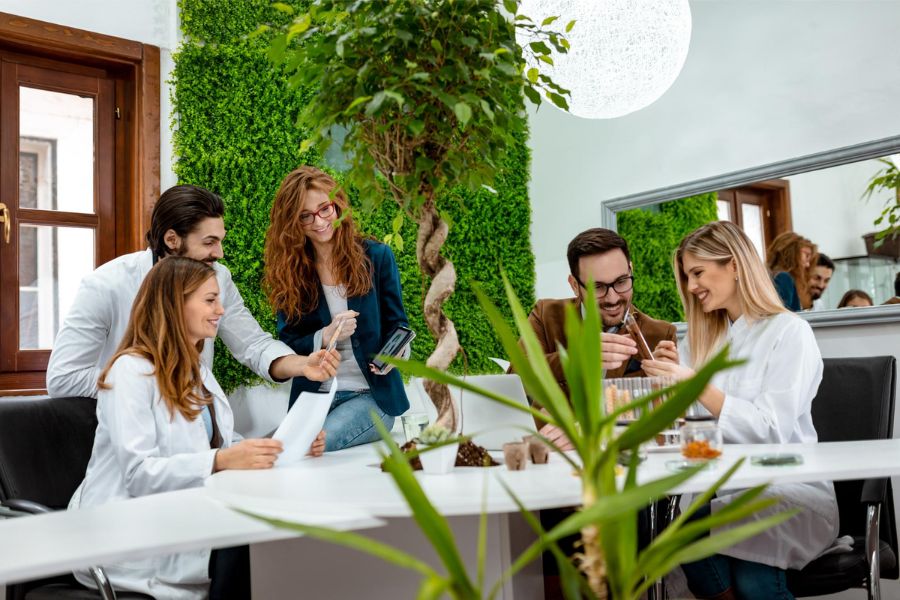
Employee engagement plays a pivotal role in the success of sustainable office design initiatives. Fostering a sense of ownership and responsibility among employees creates a more eco-conscious workplace. Consider the following strategies:
1. Educational Programs: Conduct workshops and training sessions to educate employees about the importance of sustainability and how their individual actions contribute to the overall environmental impact.
2. Green Teams: Form dedicated “green teams” within the organization to champion sustainability initiatives. These teams can brainstorm ideas, implement projects, and keep the momentum going.
3. Incentive Programs: Introduce incentive programs that reward employees for adopting sustainable practices. Recognize and celebrate achievements in waste reduction, energy conservation, and other eco-friendly actions.
4. Wellness and Sustainability Integration: Align sustainability efforts with employee wellness programs. For example, promote walking or biking to work, encourage the use of natural light, and create green spaces within the office for relaxation.
Conclusion

In conclusion, fostering a sustainable office design is not merely an environmental choice but a strategic investment in the well-being of our planet and the productivity of our workforce. The five sustainable office design ideas presented above not only contribute to a greener workspace but also embody a commitment to responsible corporate practices. Embracing elements such as energy-efficient lighting, eco-friendly furniture, indoor greenery, waste reduction systems, and flexible spaces not only reduces the ecological footprint of offices but also promotes a healthier and more dynamic work environment.
As businesses increasingly recognize the importance of sustainability StudioA, an innovative interior design firm, stands out as a pioneer in championing these principles. Their expertise in sustainable office design positions them as leaders in the industry, illustrating how thoughtful design choices can create spaces that are both aesthetically pleasing and environmentally responsible. By adopting these sustainable office design ideas, businesses can not only contribute to a more sustainable future but also enhance the overall well-being and productivity of their employees. StudioA’s commitment to sustainable design exemplifies the transformative power of conscious choices in creating a workspace that not only serves its immediate purpose but also positively impacts the world we live in.
Image Reference: Freepik
Disclaimer: All trademarks, logos, and brand names are the property of their respective owners. All company, product, and service names used in this website are for identification purposes only. Use of these names, trademarks, and brands does not imply endorsement.
